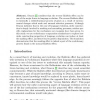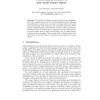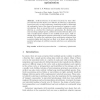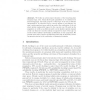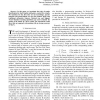ECAL
2007
Springer
14 years 3 months ago
2007
Springer
Deacon [1] considers that the reverse Baldwin effect can be one of the major forces in language evolution. The reverse Baldwin effect is essentially a redistributional process of g...
ECAL
2007
Springer
14 years 3 months ago
2007
Springer
We identify two distinct themes in social science modelling. One, more specific, approach is that of social simulation which addresses how behaviour of many actors can lead to emer...
ECAL
2007
Springer
14 years 3 months ago
2007
Springer
This paper presents computer simulations which investigate the effect that different group sizes have on the emergence of compositional structures in languages. The simulations are...
ECAL
2007
Springer
14 years 3 months ago
2007
Springer
Abstract. Artificial selection of microbial ecosystems for their collective function has been shown to be effective in laboratory experiments. In previous work, we used evolutionar...
ECAL
2007
Springer
14 years 3 months ago
2007
Springer
Often the selfish and strong are believed to be favored by natural selection, even though cooperative interactions thrive at all levels of organization in living systems. Recent em...
ECAL
2007
Springer
14 years 3 months ago
2007
Springer
odel of Embodiment on Abstract Systems: from Hierarchy to Heterarchy Kohei Nakajima, Soya Shinkai, Takashi Ikegami A Behavior-Based Model of the Hydra, Phylum Cnidaria Malin Aktius...
DIGITEL
2007
IEEE
14 years 3 months ago
2007
IEEE
We investigate the differences of the influences between robot and virtual learning companions on students' engagement. From the analysis of our experimental result and inter...
WOLLIC
2010
Springer
14 years 3 months ago
2010
Springer
sed Logic for Program Abstractions Martin Lange1 and Markus Latte2 1 Dept. of Computer Science, University of Kassel, Germany 2 Dept. of Computer Science, Ludwig-Maximilians-Univer...
CIDM
2009
IEEE
14 years 3 months ago
2009
IEEE
In this paper, we investigate the topic of gender identification for short length, multi-genre, content-free e-mails. We introduce for the first time (to our knowledge), psycholing...
CIDM
2009
IEEE
14 years 3 months ago
2009
IEEE
The graph classification problem is learning to classify separate, individual graphs in a graph database into two or more categories. A number of algorithms have been introduced fo...
